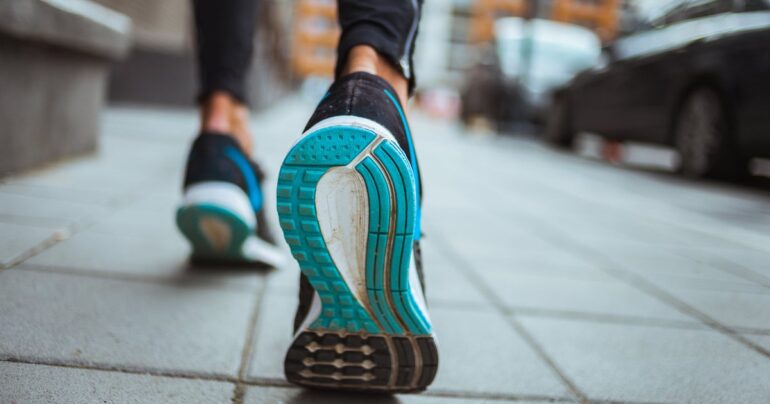🔴 Website 👉 https://u-s-news.com/
Telegram 👉 https://t.me/usnewscom_channel
Walking 10,000 steps per day has become a popular goal in the modern age, but it turns out this benchmark might not be the fitness gold standard after all.
According to a study published in The Lancet last week, getting 7,000 daily steps is enough to see meaningful health benefits. Researchers conducted a meta-analysis and systemic review of data from previous studies and found diminishing returns above that number.
Compared to walking 2,000 steps per day, reaching 7,000 steps was associated with a 47% lower risk of death, 25% lower risk of cardiovascular disease, 38% lower risk of dementia, 28% lower risk of falls, 22% lower risk of depressive symptoms, 14% lower risk of type 2 diabetes and 6% lower risk of cancer. The improvements in health outcomes beyond 7,000 steps were more modest by comparison.
“The 10,000-step target, which originated in marketing campaigns, has often been seen as too high for many,” Dr. Asim Cheema, a specialist in internal medicine and cardiology at the telehealth platform Your Doctors Online, told HuffPost.
“Even a moderate amount of daily physical activity, such as walking 7,000 steps, can have significant health benefits,” he added. “This study indicates that a lower target can still yield substantial benefits for cardiovascular health, mental well-being and overall longevity. It suggests that you don’t need to aim for the highest threshold to make meaningful changes to your health.”
Indeed, many have traced the 10,000 steps a day rule back to a 1960s Japanese marketing campaign. This kind of research offers a helpful perspective shift away from the widespread cultural fixation on getting 10K steps every single day.
“These findings are refreshing, because they challenge the ‘all-or-nothing’ mindset that often surrounds fitness,” said Anjan Pathak, co-founder of wellness platform Vantage Fit. “For years, 10,000 steps per day was treated as a universal rule, even though its roots were more commercial than scientific. This study offers a more compassionate approach.”
The Real Takeaways For Step Counts
The conclusions of the study don’t necessarily mean you should treat 7,000 steps as some new gold standard, however. These findings don’t make 10,000 steps a bad goal, either.
“For those who already walk 4,000 steps, increasing to 5,000 or more will show benefit,” said Hannah Arem, scientific director of implementation science for the health care system MedStar Health. “For those who can, reaching this goal of 7,000 is likely to increase benefits. Beyond 7,000 steps, this study suggests that the health benefits for the outcomes examined are only incremental. That said, there may be health benefits other than those assessed in this study that come from increasing step counts.”
Dr. Matthew Badgett, an internal medicine physician at Cleveland Clinic, emphasized that it’s hardly news that there are diminishing returns above a certain amount of activity. And even if certain risk reductions start to plateau above 7,000 steps, you’re still experiencing benefits when you go beyond that number.
“The study still finds that 10,000 is better than 7,000 ― it’s just not as beneficial as going from 2,000 to 7,000 steps,” he said. “I think the real takeaway is that any amount of activity is going to be beneficial, and you continue to benefit from doing more on top of that, even if the added activity doesn’t lead to as much benefit. Whether your goal is to hit 7,000 or 10,000 doesn’t really matter, but I don’t want people to see this news and decide to cut their usual 10,000 to 7,000.”
Of course, there are extreme examples of individuals who do so much physical activity that it ultimately causes harm to their bodies. But that concern does not apply to the vast majority of people.
“If the average person can go from 2,000 to 7,000 steps per day, they will benefit. And if they can go from 7,000 to 10,000, they will also benefit,” Badgett added.
“I think the real takeaway is that any amount of activity is going to be beneficial, and you continue to benefit from doing more on top of that, even if the added activity doesn’t lead to as much benefit.”
– Dr. Matthew Badgett, internal medicine physician at Cleveland Clinic
Badgett also stressed that analysis of step counts doesn’t offer the full picture of health and fitness.
“Step counters aren’t measuring exercise per se,” he said. “What if you’re a cyclist or you swim a lot or lift weights? These are forms of exercise that [don’t] show up on a step counter, but they’re still hugely beneficial for health. Even running, which is better exercise than walking, gets you fewer steps per mile, because each step moves you further.”
Badgett pointed to two important aspects of fitness: regular exercise and just generally not being sedentary.
“I think 7,000 steps a day is generally a marker of non-sedentary nature,” he said. “Someone who’s getting 2,000 steps per day is probably sitting down at their desk to work from home in the morning, and then they barely leave the desk all day, other than to go one room over for the bathroom or kitchen. And then after work, they just sit and watch TV. Someone who gets closer to 7,000 steps probably does chores around the house, might do some yard work after work, or even drives to work, which brings, inevitably, a little bit of walking.”
Indeed, getting small bursts of steps throughout the day is much healthier than sitting the whole time. If you know you aren’t being so sedentary and are also getting regular exercise, you don’t need to fixate on exact step counts.
“I talk to my patients more about moving around throughout the day and also setting aside time to do a specific exercise, whether it’s weightlifting, running or swimming,” Badgett noted. “I might explore how many steps they’re getting as a baseline to establish a goal, but for someone who is older and has physical limitations, I prefer time goals ― like 20 minutes, rather than a specific number of miles or steps. It’s all really patient-dependent.”
How To Get Your Steps In
As the Lancet study shows, even small increases in your steps can bring substantial benefits, particularly in reducing the risk of mortality and a number of health conditions.
“Move more throughout the day,” Arem advised. “That doesn’t mean you have to go to the gym if that doesn’t fit in your lifestyle. Get off the bus or subway a stop earlier. Take the stairs instead of the elevator for a floor or two. Park farther away from the door in the parking lot.”
These little changes are attainable and thus a good way to kick off your fitness journey.
“Fitness in any form is a long game, and the first priority doesn’t have to be a step count ― it should be creating the habit,” said Dave Paul, host of the “Walking Is Fitness” podcast. “Start small and pick a time of day that you can do it consistently. I mean no more than five or ten minutes. You can always add more later, but if you try and do too much to start, it can feel overwhelming, which can lead to giving up.”
Personal context matters, so you have to determine what is right for you ― whether it’s short strolls or upping your walking game with rucking.
“Begin by setting a realistic goal that you can comfortably achieve and gradually increase your steps over time,” Cheema suggested. “For example, aim to walk 2,000 steps a day and increase by 500 steps each week. It can also be helpful to break up your walking into smaller sessions throughout the day, such as walking after meals. Consistency is key to building a sustainable habit.”
He also emphasized the importance of overall lifestyle factors like nutrition, sleep and stress management. And if you have physical limitations like joint problems, turn your walks into swims or stints on the elliptical.
“I also recommend the ‘Japanese walking’ method for patients who can tolerate more intensity in their walking routines, as this has shown health benefits with a lesser overall number of steps,” said family and emergency physician Dr. Ali Shehata.
During the hot summer months, you might also move your treks to an indoor venue like the mall or treadmill section at the gym ― or even invest in your own walking pad.
“Make movement part of your routine rather than an added burden,” Pathak advised. “Walk while taking calls, park a bit farther, or take short strolls during breaks. Health isn’t about chasing perfection. It’s about showing up for yourself every day, in small, meaningful ways. If 7,000 steps a day is what gets someone moving without fear or shame, then that’s a wonderful place to start.”

